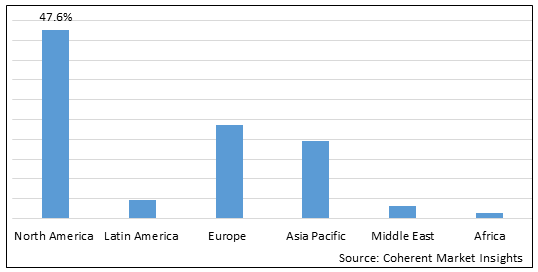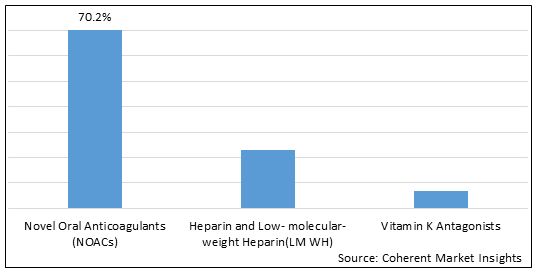The global anticoagulant market was valued at US$ 30,773.2 Mn in 2021 and is forecast to reach a value of US$ 57,337.5 Mn by 2028 at a CAGR of 9.4% between 2022 and 2028. The anticoagulant market is experiencing strong growth due to the growing prevalence of chronic disease and rise in demand for anticoagulants across the world. Moreover, rise in focus on the development of novel anticoagulants and growing geriatric population across the globe are expected to boost the growth of the market. However, factors such as side effects associated with anticoagulants and stringent government regulations are expected to hamper growth of the global anticoagulant market.
Global Anticoagulant Market: Regional Insights
Based on geography, the global anticoagulant market is segmented into North America, Latin America, Europe, Asia Pacific, and Middle East & Africa.
Among regions, North America is expected to gain highest share in the market over the forecast period due to the increase in incidence of chronic diseases (especially cardiovascular diseases) and rise in adoption of novel oral anticoagulants (NOACs) in the region. For instance, according to the American Heart Association (AHA), October 2021 report, over 2,300 people in the United States die due to cardiovascular diseases each day, an average of one death every 38 seconds. Thus, with the increase in prevalence of cardiovascular diseases (CVDs), demand for anticoagulants is also increasing, thereby driving the growth of the market.
Asia Pacific is also expected to witness significant growth in the global anticoagulant market due to the increase in prevalence of cardiovascular diseases and increase in demand for anticoagulants in the region. For instance, anticoagulants play an important role in the treatment of cardiovascular diseases (CVDs). India has one of the highest burdens of cardiovascular disease (CVD) worldwide. As per the National Center for Biotechnology Information, the annual number of deaths from CVD in India is expected to increase from 2.26 million (1990) to 4.77 million (2020). This in turn has increased the demand for anticoagulants in this region.
Figure 1. Global Anticoagulant Market Share (%), by Region, 2022

To learn more about this report, Download Free Sample
Global Anticoagulant Market Drivers:
Growing prevalence of chronic diseases across the globe is expected to boost the growth of global anticoagulant market during the forecast period. For instance, direct oral anticoagulants (DOACs) are used to prevent and treat cardiovascular disease. DOACs are anticoagulation pharmacotherapy used for the prevention of thrombosis in several cardiovascular contexts. According to the World Health Organization (WHO), cardiovascular diseases (CVDs) are the leading cause of death across the world, taking an estimated 17.9 million lives each year. This in turn is expected to increase the demand for anticoagulants around the world.
Increase in demand for anticoagulants around the world is expected to propel growth of the global anticoagulant market during the forecast period. For instance, in December 2020, Natco Pharma announced the launch of an anti-blood clot tablet, named Rivaroxaban, to treat and prevent blood clots. Rivaroxaban is currently sold by Bayer under brand name of Xarelto in the Indian market. Natco has launched RPIGAT in four strengths, 20 mg, 15 mg, 10 mg, and 2.5 mg. The novel oral anti-coagulant, Rivaroxaban, is in line with Natco’s mission of affordable medicines accessible to all, a release from Natco Pharma said.
Global Anticoagulant Market Opportunities:
Rise in focus on the development of novel anticoagulants is expected to provide significant growth opportunities for players in the global anticoagulant market. For instance, with the rise in burden of chronic diseases worldwide, the demand for safe and effective anticoagulants is also increasing with the rapid pace. In March 2021, The U.S. National Institutes of Health (NIH) initiated the last of three Phase III clinical trials of blood thinners (anticoagulant) to prevent life-threatening blood clots in adults with COVID-19 (coronavirus disease).
Growing geriatric population across the globe is expected to offer lucrative growth opportunities for players in the global anticoagulant market. For instance, the demand for improvised and non-invasive treatments is rising among geriatric population, which in turn has increased the demand for anticoagulants worldwide. According to the World Health Organization (WHO), by 2030, 1 in 6 people in the world will be aged 60 years or over, and by 2050, the world’s population of people aged 60 years and older will double (2.1 billion).
Anticoagulant Market Report Coverage
| Report Coverage | Details | ||
|---|---|---|---|
| Base Year: | 2021 | Market Size in 2021: | US$ 30,773.2 Mn |
| Historical Data for: | 2017 to 2020 | Forecast Period: | 2022 to 2028 |
| Forecast Period 2022 to 2028 CAGR: | 9.4% | 2028 Value Projection: | US$ 57,337.5 Mn |
| Geographies covered: |
|
||
| Segments covered: |
|
||
| Companies covered: |
Pfizer Inc., Sanofi SA, Dr. Reddy’s Laboratories, Aspen Holdings, Abbott Laboratories, Leo Pharma AS, Alexion Pharmaceuticals Inc., Bayer AG, Johnson & Johnson, Bristol-Myers Squibb Company, Daiichi Sankyo Company, and Boehringer Ingelheim Pharmaceuticals Inc., among others. |
||
| Growth Drivers: |
|
||
| Restraints & Challenges: |
|
||
Uncover macros and micros vetted on 75+ parameters: Get instant access to report
Global Anticoagulant Market Trends:
There is an increase in demand for direct oral anticoagulants across the world. The development and introduction of direct oral anticoagulants (DOACs) represent a huge advancement in the field of anticoagulation. Moreover, the adoption of novel oral anticoagulants (NOACs) is increasing or has increased in developing countries, and is anticipated to show a similar trend over the forecast period owing to the high preference of NOACs over the warfarin.
Moreover, the use of anticoagulants is increasing, owing to the increasing usage of plasma in the pharmaceutical industry. Apart from this, they are being used in a variety of clinical applications. These wide-ranging applications range from anti-tumor and anti-inflammatory to the prevention of infectious disease and the use as nano-carriers for drug delivery. This trend is also expected to continue over the forecast period, driving the market growth.
Global Anticoagulant Market Restraints:
Side effects associated with some anticoagulant are expected to hamper the growth of the global anticoagulant market. For instance, anticoagulant medications can cause side effects that may lead to more serious complications. The most common side effect associated with any anticoagulant is bleeding. Depending on the medicine used, other potential risks exist. They can also cause nausea, upset stomach, and diarrhea, among others.
Stringent government regulations are expected to hinder growth of the anticoagulant market. The usage of oral anticoagulants is being monitored for adverse drug events. For instance, the United States Food Drug Administration (FDA) uses standard surveillance definitions for anticoagulant-related bleeding events in post-marketing and/or epidemiologic analyses, to access the accuracy of diagnostic and procedural coding to capture anticoagulant-related bleeding events.
Figure 2. Global Anticoagulant Market Share (%), by Drug Class, 2022

To learn more about this report, Download Free Sample
Global Anticoagulant Market Segmentation:
The global anticoagulant market report is segmented into Drug Class, Application, and Geography.
Based on Drug Class, the market is segmented into Novel Oral Anticoagulants (NOACs), Heparin and Low-molecular- weight Heparin (LMWH), and Vitamin K Antagonist). Out of which, Novel Oral Anticoagulants (NOACs) Segment is expected to dominate the anticoagulant market over the forecast period and this is attributed to the increase in adoption of novel oral anticoagulants. NOACs can help prevent clots from being formed and protect one from certain types of strokes.
Heparin and Low-Molecular-Weight Heparin (LMWH) Segment is also expected to witness significant growth in the near future and this is owing to the increase in burden of chronic diseases. LMWH is used to treat cancer-related blood clots, as it is more effective than warfarin.
Based on Application, the market is segmented into Atrial Fibrillation/Myocardial Infarction (Heart Attack), Deep Vein Thrombosis (DVT), Pulmonary Embolism, and Other Applications. Out of which, Atrial Fibrillation/Myocardial Infarction (Heart Attack) Segment is expected to dominate the market during the forecast period and this is attributed to the increase in incidence of cardiovascular diseases (CVDs) across the globe.
Deep Vein Thrombosis (DVT) Segment is also expected to witness significant growth in the near future and this is owing to the increase in usage of anticoagulants. Anticoagulant therapy remains the mainstay of medical therapy for deep venous thrombosis (DVT).
Global Anticoagulant Market: Key Developments
In October 2019, Janssen Pharmaceutical Companies of Johnson & Johnson announced that the U.S. Food and Drug Administration (FDA) approved Xarelto (Rivaroxaban) for the prevention of venous thromboembolism (VTE).
In March 2019, Bristol-Myers Squibb-Pfizer Alliance announced results of Phase 4 AUGUSTUS trial evaluating Eliquis (apixaban) versus vitamin K antagonists (VKAs) in individuals with non-valvular atrial fibrillation (NVAF) and recent acute coronary syndrome (ACS) and/or undergoing percutaneous coronary intervention (PCI).
Global Anticoagulant Market: Key Companies Insights
The global anticoagulant market is highly competitive. This is attributed to the rise in demand for or increase in adoption of anticoagulants around the world, as a result, players in the market are focusing on launching novel products in the market.
Some of the key players in the global anticoagulant market are Pfizer Inc., Sanofi SA, Dr. Reddy’s Laboratories, Aspen Holdings, Abbott Laboratories, Leo Pharma AS, Alexion Pharmaceuticals Inc., Bayer AG, Johnson & Johnson, Bristol-Myers Squibb Company, Daiichi Sankyo Company, and Boehringer Ingelheim Pharmaceuticals Inc., among others.
*Definition: Anticoagulants are a class of drugs that help prevent blood clots. They're given to people at a high risk of getting clots, to reduce the chances of developing serious conditions such as strokes and heart attack. They are used to prevent and treat cardiovascular disease.
Share
Share
About Author
Ghanshyam Shrivastava - With over 20 years of experience in the management consulting and research, Ghanshyam Shrivastava serves as a Principal Consultant, bringing extensive expertise in biologics and biosimilars. His primary expertise lies in areas such as market entry and expansion strategy, competitive intelligence, and strategic transformation across diversified portfolio of various drugs used for different therapeutic category and APIs. He excels at identifying key challenges faced by clients and providing robust solutions to enhance their strategic decision-making capabilities. His comprehensive understanding of the market ensures valuable contributions to research reports and business decisions.
Ghanshyam is a sought-after speaker at industry conferences and contributes to various publications on pharma industry.
Missing comfort of reading report in your local language? Find your preferred language :
Transform your Strategy with Exclusive Trending Reports :
Frequently Asked Questions
Select a License Type
Joining thousands of companies around the world committed to making the Excellent Business Solutions.
View All Our Clients